Begonia - The Ultimate Growing Guide from Proven Winners®
With fancy foliage and long-blooming flowers, begonias add nonstop color to outdoor landscapes and home interiors.
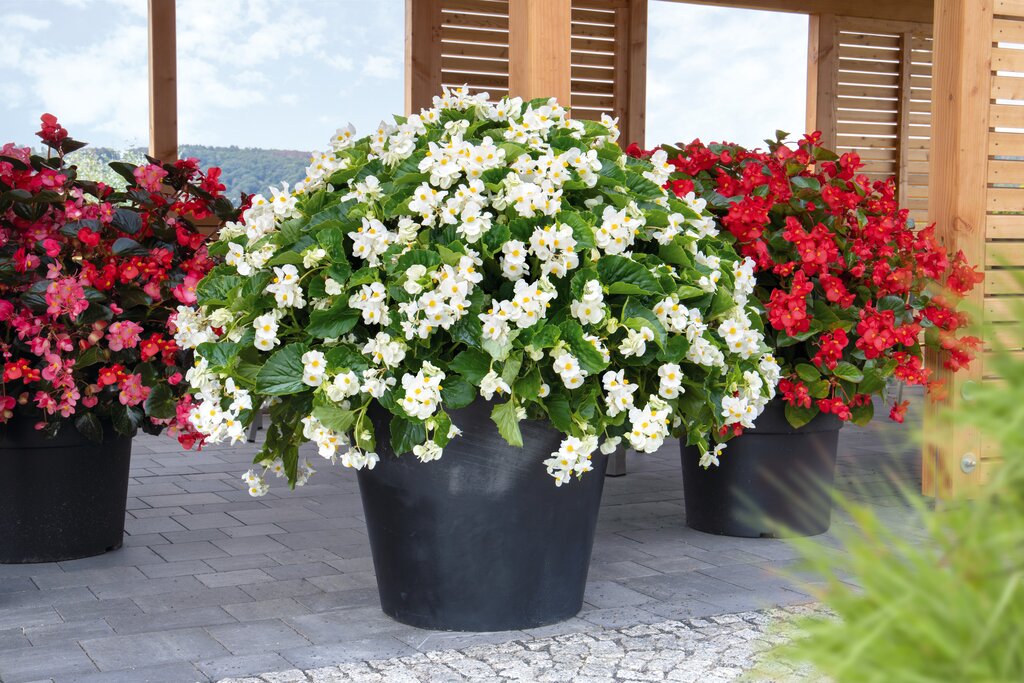
Buy begonia plants - Order online and have them shipped right to your door
Begonia is a semi-tropical or tropical ornamental plant grown for its attractive flowers and brightly colored leaves. Long been a staple bedding plant for shade gardens, it is versatile when used in beds, borders, mass plantings, containers and as indoor houseplants.
Native to Central and South America, Asia and Africa, begonias are tolerant of low light conditions, making them invaluable for brightening up shady spots. Here’s how to grow and care for these plants, along with tips on how to use them in your landscape.
WHAT TYPE OF BEGONIA DO I HAVE?
There are many different types of begonia plants. Here are the most commonly grown:
Wax begonias have waxy green or bronze foliage and white, red or pink flowers. Plants are compact, 6 to 12 inches tall and wide, and are commonly grown as a bedding plant.
Rhizomatous begonias are characterized by rhizomes that grow horizontally near the surface of the soil where the plants sprout new growth. Foliage comes in a wide range of colors, shapes and patterns.
Tuberous begonias grow from tubers and go dormant in winter. Large brightly colored flowers and a trailing growth habit make these especially suited to hanging baskets.
Cane begonias have an upright growth habit and include varieties with decorative foliage such as Angel Wing begonias.
Rex begonias are grown for the highly decorative foliage. Leaves come in a wide range of shapes and patterns, in hues of red, pink, burgundy, purple, green and silver.
PLANTING BEGONIAS
How to plant: Wait to plant outdoors until nighttime temperatures are consistently 50 degrees F or warmer. Choose a protected site with rich, well-draining soil. Begonia light requirements can vary, from full sun to shade. Provide shelter from hot afternoon sun. Follow these steps and space plants 6 to 18 inches apart, depending on the variety.
- Loosen soil in the planting area. Dig a hole slightly wider and deeper than the root ball.
- Remove the begonia plant from its nursery pot and gently tease out roots if potbound.
- Set the plant in the hole with the base level with the surrounding soil.
- Backfill the hole with soil, tamp down slightly to remove air pockets and water well.
- Keep plants watered regularly until established.
HOW TO CARE FOR BEGONIAS
When caring for begonias, follow these tips:
Soil: Begonias prefer rich, well-drained soil. For those in pots, use a high quality all-purpose potting mix. Make sure containers have adequate drainage holes.
Watering: Keep soil evenly moist but not soggy. Allow the top 2 inches of soil to dry out in between waterings. Begonias are somewhat drought-tolerant once established. Overwatering can cause root rot. Avoid getting the leaves wet to prevent fungal diseases such as powdery mildew.
Fertilizing: Begonias grow best with regular fertilizer. As part of regular begonia care, apply a balanced slow-release granular fertilizer at the time of planting, or use a liquid fertilizer once a month during the growing season.
Pruning: Begonias need little or no pruning. Stem tips can be pinched back if plants become too leggy. Begonia flowers are self-cleaning and need no deadheading.
Additional care: Overwinter begonia plants indoors as houseplants. Bring inside before temperatures drop below 50 degrees F. Place in a window with bright light and reduce watering, keeping soil only slightly moist.
Tuberous begonias go dormant in winter. Store tubers in peat moss or sawdust and keep in a cool place (50 degrees F is optimal). In early spring, repot in fresh potting soil and wait until temperatures are consistently 50 degrees F or above at night to place plants outdoors.
Find more tips on overwintering begonias.
TRY THESE PROVEN WINNERS® BEGONIA VARIETIES
Add these begonia varieties to your landscape:
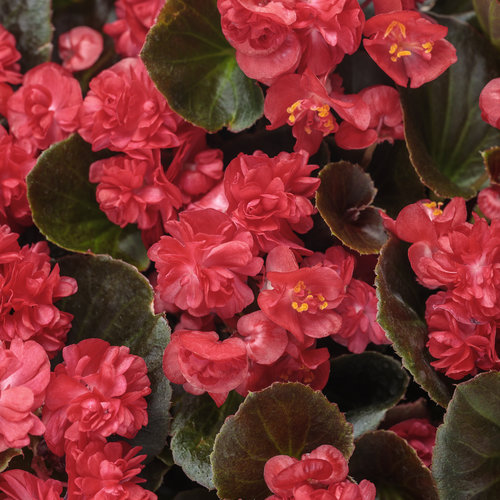 Double Up™ Red (Begonia semperflorens) is a wax begonia with double lipstick-red flowers and dark burgundy-green foliage. Plants are tolerant of sun and shade, making them suitable for transitional or mixed-light areas. More vigorous than older varieties, Double Up™ Red has a compact habit and self-cleaning flowers that need no deadheading. |
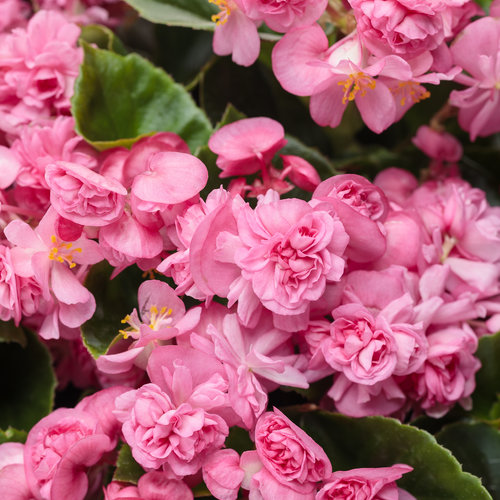 Double Up™ Pink (Begonia semperflorens) is a pink begonia with double blooms that stand out against the glossy dark green leaves. Dense vigorous plants bloom nonstop all summer long. Self-cleaning flowers and tolerance of shade or sun make this a good low-maintenance choice as a bedding plant or in containers. |
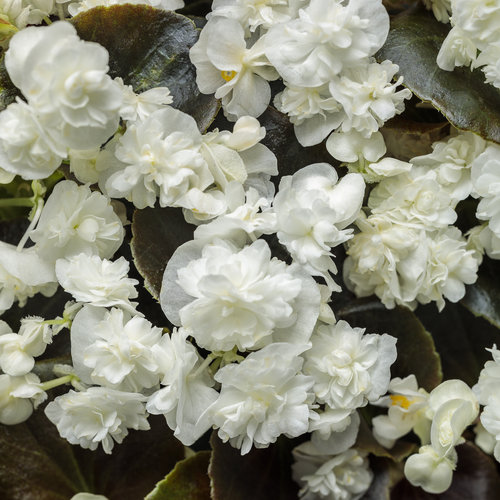 Double Up™ White (Begonia semperflorens) has a dense, compact habit with prolific blooms. Pure white double flowers provide a pleasing contrast to dark burgundy-green foliage. This versatile selection goes well with every style and color landscape. Use to edge borders and pathways, or in mass plantings. |
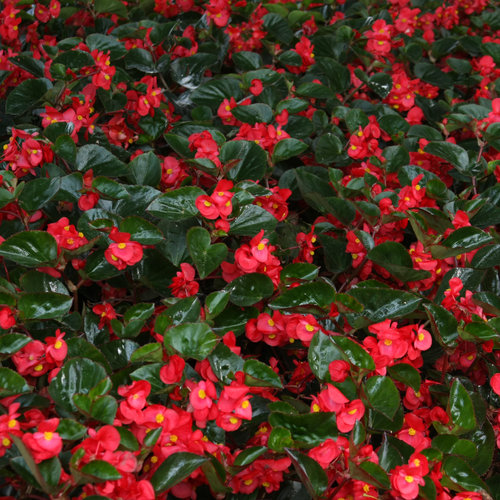 Surefire® Red (Begonia benariensis) grows taller and wider than standard wax begonias, with larger flowers. Dense upright plants bloom nonstop through summer. Single open-faced flowers are rich red, with a backdrop of glossy dark green foliage. Surefire® Red begonia makes a dramatic statement in mass plantings and containers. |
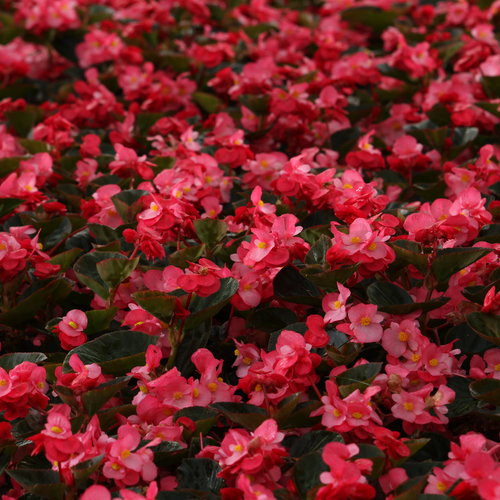 Surefire® Rose (Begonia benariensis) has large deep pink flowers and dark reddish-brown foliage produced on tall, vigorous plants. Tolerant of both sun and shade, this vigorous variety blooms continuously from planting until frost. Mass in the landscape or combine as a thriller element in containers with other shade-tolerant annuals. |
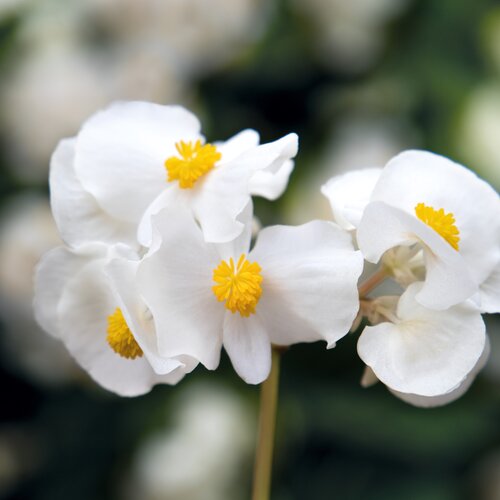 Surefire® White (Begonia benariensis) performs well in a wide range of growing conditions including sun and shade. Bright green foliage complements the single pure white flowers, which bloom nonstop from planting until frost. Self-cleaning plants offer easy low-maintenance color in borders, mass plantings and containers. |
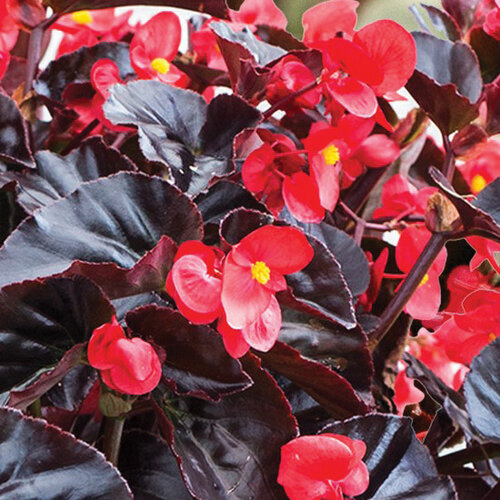 Surefire® Cherry Cordial™ (Begonia x hybrida) has dark purple, almost black foliage and bright red flowers that add dramatic contrast to the landscape. Compact spreading plants bloom through summer, adding continuous color to beds, borders and containers. Self-cleaning flowers need no deadheading. |
 Double Delight® Blush Rose (Begonia tuberhybrida) is a tuberous begonia with lightly fragrant flowers in warm pastel tones of coral-pink and yellow. Large double rose-like blooms are produced on vigorous trailing plants that are perfect for hanging baskets. Tubers can be dug up and stored indoors for replanting the following growing season. |
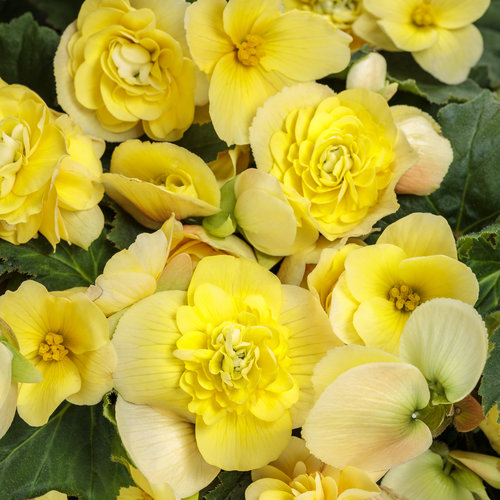 Double Delight® Primrose (Begonia tuberhybrida) is a yellow begonia with soft apricot accents. Scented double flowers are produced on sturdy trailing stems, making this variety ideal for patio planters and hanging baskets. Overwinter tubers indoors to replant the following spring. |
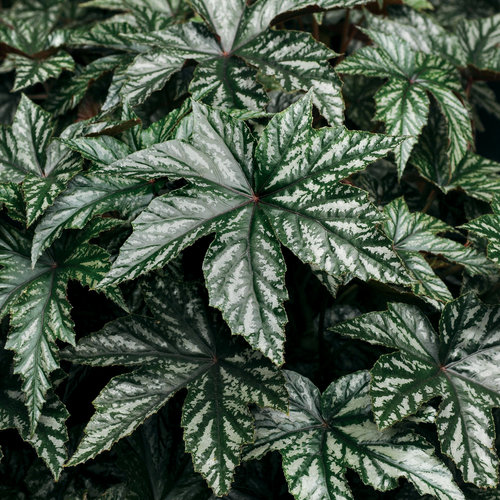 Proven Accents® Pegasus (Begonia hybrid) is grown for the attractive dissected foliage which is dark green with silver patterns. Mass in a bed for an eye-catching display, or plant in a container as a thriller element in combination with other warm-season annuals. Plants can be overwintered indoors as houseplants. |
BEGONIA FAQ’s
Are begonias perennials?
These tender plants are hardy in USDA Zones 9-11. Begonias are perennial in frost-free regions and annual in colder climates unless they are brought indoors for the winter.
Begonias sun or shade?
Begonias are tolerant of a range of light conditions, from full sun to shade. In colder climates, plants can tolerate more light. In warm regions, they need protection from hot afternoon sun to prevent leaf scald. Varieties with darker foliage can withstand more light than those with green leaves.
Do begonias come back every year?
Begonias can live outdoors from year to year in frost-free regions or overwintered indoors as houseplants.
How to keep begonias blooming?
Provide regular water, fertilizer and optimal light conditions to keep begonia plants blooming.
Can begonias take full sun?
Begonias can tolerate full sun in northern climates, but do best with partial shade.
HOW TO USE BEGONIAS IN YOUR LANDSCAPE
There are many ways to display begonias outdoors or in your home. Here are some ideas:
- Mass wax begonias in a semi-shaded bed for continuous color all summer long.
- Place different colored tuberous begonias in hanging baskets and display along your front porch to make a dazzling first impression.
- Edge a shaded pathway or border with wax begonias for low-maintenance color from planting until frost.
- Combine begonias with other warm-season annuals in a decorative container on a porch, patio, balcony or deck.
- Mass begonias underneath a shade tree to brighten up a dark area of your yard.
- Use rex begonias as a foliage element in containers, beds and borders.
- Adorn window boxes with begonias combined with other shade-tolerant annuals such as wishbone flower, coleus, lobelia and sweet potato vine.
- Use an upright begonia as a thriller element or a trailing type as a spiller element in a container in combination with other annuals to create a “filler, thriller, spiller” effect.
- Use begonia indoor houseplants to dress up a table, shelf or desktop to help stave off the winter blues.
Related: 10 Ways to Boost Your Home's Curb Appeal with Flowers
BEGONIA COMPANION PLANTS
Combine begonias alongside other plants with similar cultural needs of partial sun, rich well-draining soil and regular water.
For hanging baskets, combine Double Delight® tuberous begonias with:
- Proven Accents® Silver Falls™ dichondra
- Proven Accents® Sweet Caroline Sweetheart Lime sweet potato vine
- ColorBlaze® Royale Cherry Brandy® coleus
- Catalina® Midnight Blue wishbone flower
For beds and borders, mass Double Up™ wax begonias alongside:
- Silver Cascade® dusty miller
- Unplugged® So Blue™ mealycup sage
- Heart to Heart® ‘Lemon Blush’ caladium
- Artist® Pearl flossflower
For decorative containers, plant Surefire® hybrid begonias with:
- Graceful Grasses® Queen Tut™ dwarf papyrus
- Diamond Snow® euphorbia
- Angelface® Super Blue angelonia
- Supertunia Vista® Bubblegum® petunia
Find more begonia recipes.




